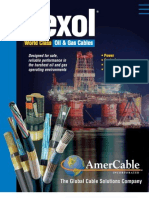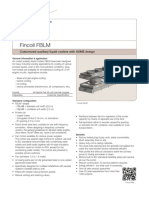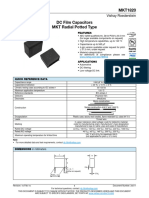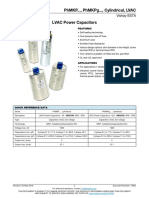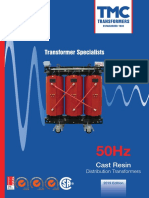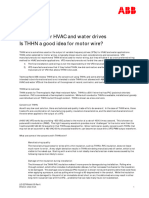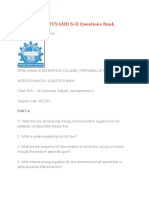Vishay Solid Tantalum Capacitors FAQ
Vishay Solid Tantalum Capacitors FAQ
Uploaded by
Chen Chun-LiCopyright:
Available Formats
Vishay Solid Tantalum Capacitors FAQ
Vishay Solid Tantalum Capacitors FAQ
Uploaded by
Chen Chun-LiCopyright
Available Formats
Share this document
Did you find this document useful?
Is this content inappropriate?
Copyright:
Available Formats
Vishay Solid Tantalum Capacitors FAQ
Vishay Solid Tantalum Capacitors FAQ
Uploaded by
Chen Chun-LiCopyright:
Available Formats
Frequently Asked Questions
www.vishay.com
Vishay
Solid Tantalum Capacitors
Frequently Asked Questions (FAQs)
GENERAL
• What is Vishay’s selection of tantalum capacitors with solid MnO2 electrolyte?
• What are your cage codes?
• Is my part counterfeit?
• What is the CTE of tantalum capacitors?
• What is the shelf life of this part in the original packaging?
• How can I obtain tin whisker growth information?
• What is the flammability rating of this tantalum capacitor per UL 94 V-0/1/2?
APPLICATIONS
• For DC/DC converters, what are the recommended design-in guidelines for Vishay tantalum capacitors?
• How can I avoid the overstressing of tantalum capacitors that can lead to overheating and possibly ignition?
• Can Vishay tantalum capacitors be used at temperatures above 125 °C?
ENVIRONMENTAL
• Are all Vishay solid tantalum capacitors RoHS-compliant?
• Where do I get RoHS, REACH, Green, and halogen-free status, and material declaration documentation?
• What is your position on DFAR clause 252.225-7009, Restriction on Acquisition of Certain Articles Containing Specialty
Metals?
MATERIALS AND CONSTRUCTION
• What are the materials used in a tantalum capacitor and what is the typical weight?
• What is the termination structure of Vishay tantalum capacitors?
MARKING, PACKAGING, AND LABELING
• How do you identify the correct polarity for Vishay solid tantalum capacitors?
• How do I determine the date code on a molded tantalum chip capacitor?
• How are hermetically sealed / metal case tantalum capacitors marked?
• How are tantalum capacitors packaged? What are your bulk packaging options?
• What labeling information is present on reels and boxes of tantalum capacitors?
PERFORMANCE AND RELIABILITY
• How can the reliability of solid capacitors be calculated?
• How long can you operate Vishay solid tantalum capacitors with applied reverse voltage bias?
• What is the self-healing effect for tantalum capacitors?
• How do I know if I am exceeding the ripple current capability of the capacitor?
• Do you have a SPICE model for this capacitor?
STORAGE, PROCESSING, AND MOUNTING
• What is the shelf life of this part in the original packaging?
• What is the recommended storage temperature for solid tantalum capacitors?
• What is the moisture sensitivity of Vishay solid tantalum capacitors?
• Is attachment with a soldering iron a recommended method for capacitors attachment?
TECHNICAL
• Why are voltage and temperature derating needed for tantalum capacitors?
• What is the difference between fused (Vishay TMCTX, T96, T98) and standard, non-fused (Vishay TMCS, 293D, T95, T97, and
others) tantalum capacitors?
• Are solid tantalum capacitors available in hermetic packaging?
• How do I obtain ESR / Z vs. frequency data?
• Are tantalum capacitors ESD-sensitive?
• What is the ESL of this part?
• What are the test conditions for standard electrical measurements (capacitance, dissipation factor, ESR)?
• How do I test for DC leakage (DCL) of Vishay tantalum capacitors?
• Why is surge testing done on tantalum capacitors and how is it performed?
• What is Weibull grading?
• What is the major difference between tantalum Mn02 and tantalum polymer capacitors?
Revision: 22-Jul-2020 1 Document Number: 40110
For technical questions, contact: tantalum@vishay.com
THIS DOCUMENT IS SUBJECT TO CHANGE WITHOUT NOTICE. THE PRODUCTS DESCRIBED HEREIN AND THIS DOCUMENT
ARE SUBJECT TO SPECIFIC DISCLAIMERS, SET FORTH AT www.vishay.com/doc?91000
Frequently Asked Questions
www.vishay.com
Vishay
GENERAL
Q: What is Vishay’s selection of tantalum capacitors with solid MnO2 electrolyte?
A: See section “Vishay Selection” below.
Q: What are your cage codes?
A: Vishay manufactures solid tantalum capacitors in four locations: Dimona, Israel (cage code 2800A); Bennington, VT, USA
(cage code 05079); Danshui, China (cage code SDU70); Miharu, Japan (cage code SXP61).
Contact tantalum@vishay.com for information on a particular capacitor series.
Q: Is my part counterfeit?
A: The best way to avoid receiving counterfeit parts is to buy products through Vishay-authorized channels. For more
information on Vishay’s policy on counterfeit component purchases, go to www.vishay.com/doc?99907.
Q: What is the CTE of tantalum capacitors?
A: CTE (coefficient of thermal expansion) for conformal coated and lead frameless MICROTAN® tantalum capacitors is
approximately 10 ppm/°C, which is suitable for use in both FR4 and alumina substrate applications. Terminations of molded
tantalum chip capacitors utilize a compliant lead frame construction - the leadframe can flex slightly to minimize any effects
due to mismatch in CTE. As a result, CTE mismatches are not applicable.
Q: What is the shelf life of this part in the original packaging?
A: The following is the position of the EIA/ECA P-2.5 Engineering Committee for Tantalum Capacitors: solid tantalum capacitors
have no known wear-out mechanism or shelf-life limitations. However, solderability and cover-tape peel strength may be
affected by storage conditions. See FAQ “What is recommended storage temperature for solid tantalum capacitors” (see
section Storage, Processing, and Mounting).
Q: How can I obtain tin whisker growth information?
A: For general information go to www.vishay.com/how/leadfree/#whisker.
For family-specific information, please send part number request to tantalum@vishay.com.
Q: What is the flammability rating of tantalum capacitors per UL 94 V-0/1/2?
A: All solid tantalum capacitor encapsulation materials meet a flammability rating of UL 94 V-0.
VISHAY SELECTION
Q: What is Vishay’s selection of tantalum capacitors with solid MnO2 electrolyte?
A. Vishay Sprague surface-mount chip capacitors, B. Vishay Polytech, surface-mount chip capacitors,
TANTAMOUNT™, molded case, metal leadframe molded case, metal leadframe
• 293D industrial grade • TMCS standard industrial grade
• 593D industrial grade, low ESR • TMCM extended range
• TR3 low ESR • TMCU ultra flat, low profile
• TP3 high performance, automotive grade • TMCJ molded case, 0603 size
• TH3 high temperature, 150 °C, automotive grade • TMCP molded case, 0805 size
• TH4 high temperature, 175 °C, automotive grade • TMCTX built-in-fuse
• TH5 HITM® very high temperature, 200 °C • TMCR low ESR
• TL3 very low DC leakage B1. Vishay Polytech, high reliability
• TM3 for medical instruments • TMCH hi rel
• 793DX CECC 30801/005 approved • THC high temperature 150 °C, hi rel
• CTC3 CECC 30801/009 approved C. Vishay Sprague surface-mount chip capacitors,
• CTC4 CECC 30801/011 approved TANTAMOUNT™, conformal coated case
A1. TANTAMOUNT™, molded case, metal leadframe, high • 194D metal end caps
reliability, and DLA approved • 195D conformal coated
• CWR11 MIL-PRF-55365/8 qualified • 572D low profile, maximum CV
• 95158 DLA approved, low ESR • 591D low profile, low ESR, maximum CV
• T83 Hi rel COTS • 592D low profile, maximum CV
• 592W low profile, pulse application capacitor
• 594D maximum CV, low ESR
• 595D maximum CV
• 597D ultra low ESR, maximum CV (multianode)
• 695D pad-compatible with CWR06 / 194D
Revision: 22-Jul-2020 2 Document Number: 40110
For technical questions, contact: tantalum@vishay.com
THIS DOCUMENT IS SUBJECT TO CHANGE WITHOUT NOTICE. THE PRODUCTS DESCRIBED HEREIN AND THIS DOCUMENT
ARE SUBJECT TO SPECIFIC DISCLAIMERS, SET FORTH AT www.vishay.com/doc?91000
Frequently Asked Questions
www.vishay.com
Vishay
C1. TANTAMOUNT™, conformal coated case, high reliability F. Vishay Sprague through-hole mounted capacitors, resin
and DLA approved coated, radial leads
• CWR06 MIL-PRF-55365/4 qualified • 199D TANTALEX™, dipped
• CWR16 MIL-PRF-55365/13 qualified, extended range • 299D TANTALEX™, dipped, triple lead
• CWR26 MIL-PRF-55365/13 qualified, low ESR • 489D, dipped
• 13008 DLA approved, ultra low ESR (multianode) • 499D, dipped
• 14002 DLA approved, low ESR • ETQW, dipped
• T95 hi rel COTS • ETPW, dipped
• T96 hi rel COTS, low ESR, built-in-fuse • 790D, molded
• T97 ultra low ESR, hi rel COTS (multianode)
G. Vishay Sprague through-hole mounted capacitors, resin
• T98 ultra low ESR, hi rel COTS, built-in-fuse molded, axial leads
(multianode)
• 173D
D. Solid tantalum SMD capacitors TANTAMOUNT™, hi rel H.Vishay Sprague through-hole mounted capacitors,
COTS, low ESR, hermetically sealed / metal case TANTALEX™, hermetically sealed / metal case, axial leads
• T25
• 150D
E. Vishay Sprague surface-mount chip capacitors, • 152D extended range
MICROTAN®, molded, leadframeless • 550D for high-frequency power supplies
• 298D case sizes from 0402 to 1411 • CTS1 CECC 30201/002 approved
• 298W extended range • CTS13 CECC 30201/005 approved
• TR8 MICROTAN® terminations, low ESR • 749DX CECC 30201/029 approved
• TL8 high CV, low DC leakage
• TP8 high performance, automotive grade I. Vishay Sprague through-hole mounted capacitors,
TANTALEX™, hermetically sealed / metal case, axial
leads - DLA approved
E1. MICROTAN®, high reliability and DLA approved
• M39003/01 (style CSR13) MIL-PRF-39003/1 qualified
• 11020 DLA approved
• M39003/03 (style CSR23) MIL-PRF-39003/3 qualified
• TM8 hi rel COTS, low DC leakage
• M39003/09 (style CSR21) MIL-PRF-39003/9 qualified
APPLICATIONS
Q: For DC/DC converters, what are the recommended design-in guidelines for Vishay tantalum capacitors?
A: There are several basic converter topologies: buck, boost, and flyback. Various capacitor types can be used in the input and
outputs of DC/DC converters. The application typically dictates the best choice of capacitor type (MLCC, aluminum
electrolytic, polymer, or tantalum) to use in the design. Some important considerations for input capacitors used in DC/DC
converters are the power dissipation and ripple performance. To maintain the voltage and to make sure the rail voltage is
stable to the converter, an input capacitor is required.
The Vishay datasheet contains maximum ESR information, which is useful in determining how to right-size the capacitor for
the available AC current. Maximum power dissipation and ripple current capabilities can be found in datasheets or
application notes on the Vishay website.
The hold up capacitor(s) is needed in converters for controlling the output ripple and transients. Output ripple can be
controlled by the capacitor. Key considerations for ripple control are the capacitor’s equivalent series resistance (ESR).
Transients during light- and heavy-load conditions need to be evaluated with the selected capacitor. Vishay can supply
impedance vs. frequency information so the ESR and ESL can be used to determine the proper type capacitor for the
application capacitance for the output of the converter.
Contact your local Vishay application engineer for more assistance in selecting the right capacitor for your converter
application.
Q: How can I avoid the overstressing of tantalum capacitors that can lead to overheating and possibly ignition?
A: Solid tantalum capacitors have no known wear-out mechanism(s). However, excessive voltage, current, and temperature can
impact their long-term reliability. Reducing any of the mentioned stresses results in improved reliability. The most common
method for reducing tantalum dielectric stress to improve reliability and guard against catastrophic failure is to reduce the
applied voltage so that it is less than the capacitor’s rated voltage (normally a 60 % to 50 % voltage derating is recommended
for solid tantalum capacitors. For individual devices please refer to the recommended voltage derating table in the relevant
datasheet, or in product Typical Performance Characteristics, or see technical note 40246 “Solid Tantalum Capacitors (With
MnO2 Electrolyte) Voltage Derating” www.vishay.com/doc?40246).
Q: Can Vishay solid tantalum capacitors be used at temperatures above 125 °C?
A: Yes. The TH3 series is designed for up to 150 °C applications, the TH4 up to 175 °C, and the TH5 up to 200 °C.
Revision: 22-Jul-2020 3 Document Number: 40110
For technical questions, contact: tantalum@vishay.com
THIS DOCUMENT IS SUBJECT TO CHANGE WITHOUT NOTICE. THE PRODUCTS DESCRIBED HEREIN AND THIS DOCUMENT
ARE SUBJECT TO SPECIFIC DISCLAIMERS, SET FORTH AT www.vishay.com/doc?91000
Frequently Asked Questions
www.vishay.com
Vishay
ENVIRONMENTAL
Q: Are all Vishay solid tantalum capacitors RoHS-compliant?
A: All commercial solid tantalum capacitors are offered with a RoHS-compliant material option.
Q: Where do I get RoHS, REACH, Green, halogen-free status, and material declaration documentation?
A: Send an email to VPECM.surveys@vishay.com. Include specific part number(s) in your request.
Q: What is your position on DFAR clause 252.225-7009, Restriction on Acquisition of Certain Articles Containing
Specialty Metals?
A: All electronic components, therefore all tantalum capacitors, are covered by exception to this clause.
MATERIALS AND CONSTRUCTION
Q: What are the materials used in a tantalum capacitor and what is the typical weight?
A: Major materials used in tantalum capacitors are: tantalum powder, tantalum wire, Mn Nitrate, silver-filled paints / adhesives,
metal leadframe (molded chip with metal leadframe only), and plastic encapsulant (except: hermetically sealed capacitors
with metal case).
For component weight information and for material content (declaration) data please send a request to
VPECM.surveys@vishay.com.
Please note the full Vishay part number.
Q: What is the termination structure of Vishay tantalum capacitors?
A: All surface-mount solid tantalum capacitors from Vishay have a nickel barrier layer covered by an outer termination finish.
Vishay offers termination finishes of 100 % matte tin, tin / lead, and gold for certain product series. Please refer to specific
product datasheets. For typical layer thickness contact tantalum@vishay.com.
MARKING, PACKAGING, LABELING
Q: How do you identify the correct polarity for Vishay solid tantalum capacitors?
A: Because tantalum capacitors are polarized devices, they can be damaged if the capacitor is connected using the wrong
polarity. The oxide dielectric construction that is used in tantalum capacitors has a basic rectified property which blocks
current flow in one direction and at the same time offers a low resistance path in the opposite direction. Attention to
maintaining the proper polarity when using tantalum capacitors is very important. The anode of the tantalum capacitor is the
positive (+) terminal, while the cathode is the negative (-) terminal. Vishay surface-mount tantalum capacitors are clearly
marked with a white bar which indicates the anode terminal of the part. The anode of leaded (through-hole) capacitors is
marked with a plus symbol(s).
Conformal-coated capacitors (with orange epoxy coating) do not have body markings, but their anode terminal can be easily
identified by their tantalum wire nib.
Q: How do I determine the date code on a molded tantalum chip capacitor?
A: On case sizes B, C, D, E, V, and W, the date code is a two-digit alpha numeric code. As shown in the next table, the “N3” is
the date code which represents March 2001. On case A, the date code designation is done with combination of strokes; for
details see tables below.
Revision: 22-Jul-2020 4 Document Number: 40110
For technical questions, contact: tantalum@vishay.com
THIS DOCUMENT IS SUBJECT TO CHANGE WITHOUT NOTICE. THE PRODUCTS DESCRIBED HEREIN AND THIS DOCUMENT
ARE SUBJECT TO SPECIFIC DISCLAIMERS, SET FORTH AT www.vishay.com/doc?91000
Frequently Asked Questions
www.vishay.com
Vishay
Date codes for B, C, D, V, E, and W may be decoded as follows:
YEAR CODE MONTH CODE
1990 / 2010 A JANUARY 1
1991 / 2011 B FEBRUARY 2
1992 / 2012 C MARCH 3
1993 / 2013 D APRIL 4
1994 / 2014 E MAY 5
1995 / 2015 F JUNE 6
1996 / 2016 H JULY 7
1997 / 2017 J AUGUST 8
1998 / 2018 K SEPTEMBER 9
1999 / 2019 L OCTOBER O
2000 / 2020 M NOVEMBER N
2001 / 2021 N DECEMBER D
2002 / 2022 P
2003 / 2023 R
2004 / 2024 S
2005 / 2025 T
2006 / 2026 U
2007 / 2027 V
2008 / 2028 W
2009 / 2029 X
Date codes for A case repeat every four years and may be decoded as follows:
1999 / 2003 2000 / 2004 2001 / 2005 2002 / 2006
MONTH 2007 / 2011 2008 / 2012 2009 / 2013 2010 / 2014
2015 / 2019 2016 / 2020 2017 / 2021 2018 / 2022
January C105 C105 C105 C105
February C105 C105 C105 C105
March C105 C105 C105 C105
April C105 C105 C105 C105
May C105 C105 C105 C105
June C105 C105 C105 C105
July C105 C105 C105 C105
August C105 C105 C105 C105
September C105 C105 C105 C105
October C105 C105 C105 C105
November C105 C105 C105 C105
December C105 C105 C105 C105
Q: How are hermetically sealed / metal case tantalum capacitors marked?
A: Marking on metal case of hermetically sealed capacitors (series 150D / 152D / 550D / CTS1 / CTS13 / 749DX) shows: series
name, tolerance in percents (for CTS1 / CTS13 / 749DX - as one digit code: J - for ± 5 %, K - for ± 10 %, M - for ± 20 %),
capacitance value in microfarads, rated voltage in volts, date code (four digit: YYWW), Vishay marking (circled two), polarity
signs (pluses). For lead (Pb)-free capacitors capital letter L is added after date code. There is slight variation between different
case sizes. Typical marking example is shown below:
150D ± 10 %
10UF +
20DC +
2
Date code +
Revision: 22-Jul-2020 5 Document Number: 40110
For technical questions, contact: tantalum@vishay.com
THIS DOCUMENT IS SUBJECT TO CHANGE WITHOUT NOTICE. THE PRODUCTS DESCRIBED HEREIN AND THIS DOCUMENT
ARE SUBJECT TO SPECIFIC DISCLAIMERS, SET FORTH AT www.vishay.com/doc?91000
Frequently Asked Questions
www.vishay.com
Vishay
For military style hermetically sealed capacitors (M39003/01, /03, /09) marking shows: military specification number,
specification sheet number, dash number, surge current option letter (if applicable) and “J” for JAN, cage code, lot date code,
Vishay marking (circled two), polarity signs (pluses). Capacitance value (in microfarads), tolerance, and rated voltage (in volts)
are shown on bigger case sizes only. Typical marking example is shown below:
M39003
03 - 2 +
XXXXJ
Cage code +
Lot date code
Q: How are tantalum capacitors packaged? What are your bulk packaging options?
A: Standard packaging for surface-mount tantalum chip capacitors is 8 mm to 24 mm plastic embossed tape on 7" (178 mm)
and 13" (330 mm) reels per EIA-481. Specific reel quantities and other packaging options are specified in each datasheet.
All through-hole solid tantalum capacitors are available with tape and reel or ammopack packaging and, except for the 173D
series, with bulk packaging. Standard packaging options and ordering information for each series are specified in datasheets.
Q: What labeling information is present on reels and boxes of tantalum capacitors?
A: Vishay provides the customer part number, shipping order number, customer order number, and date code information as
it pertains to manufacturing date and reeling date. Full traceability is available for all shipments. For more information, contact
your Vishay sales representative.
PERFORMANCE AND RELIABILITY
Q: How can the reliability of solid capacitors be calculated?
A: Vishay calculates solid tantalum capacitor reliability based upon MIL-HDBK-217. For your reliability calculations, refer to
Vishay’s FIT calculator program. The Vishay FIT calculator program was developed using the calculations defined in
MIL-HDBK-217 (revision F). This FIT calculator program enables users to predict the reliability of tantalum capacitors. Vishay
customers can input information about applications, ambient temperature, operating voltage, and environmental factors to
create multipliers of established failure rates for most tantalum capacitor types. The failure rates are listed as “FIT” (failures
in time) and as “MTBF” (mean time between failures). Vishay’s FIT calculator program enables instantaneous results and
provides important design-related information.
The Vishay FIT calculator can be found at: www.vishay.com/capacitors/tantalum-reliability-calculator-list/.
Q: How long can you operate Vishay solid tantalum capacitors with the applied reverse voltage bias?
A: Because tantalum capacitors are polarized devices, they can be damaged if the capacitor is connected using the wrong
polarity. The oxide dielectric construction that is used in tantalum capacitors has a basic rectified property which blocks
current flow in one direction and at the same time offers a low resistance path in the opposite direction.
Vishay does not recommend the intentional application of reverse voltage on solid tantalum capacitors. However,
occasionally tantalum capacitors may be subjected to reverse voltages. Solid tantalum capacitors are capable of
withstanding short duration peak voltages in the reverse direction limited to 5 % of the DC rating at +25 °C, 3 % of the DC
rating at +85 °C, and 1 % of the rated voltage at +125 °C.
In addition to the voltage limits above, the time to failure and risk of damage due to reverse voltage are also dependent on
the temperature and available current in the application.
Tantalum capacitors can handle a reverse voltage if oriented in a “back-to-back” (or cathode-to-cathode) configuration.
The “back-to-back” configuration is a good method for handling bipolar filtering applications.
C1
C2
In the configuration above, C1 and C2 should each individually meet the circuit voltage and derating requirements.
If C1 is equal to C2, the resulting capacitance of the Ctotal is half the value of each capacitor (example: if C1 and C2 are each
22 μF, then Ctotal is 11 μF).
Revision: 22-Jul-2020 6 Document Number: 40110
For technical questions, contact: tantalum@vishay.com
THIS DOCUMENT IS SUBJECT TO CHANGE WITHOUT NOTICE. THE PRODUCTS DESCRIBED HEREIN AND THIS DOCUMENT
ARE SUBJECT TO SPECIFIC DISCLAIMERS, SET FORTH AT www.vishay.com/doc?91000
Frequently Asked Questions
www.vishay.com
Vishay
Q: What is the self-healing effect for tantalum capacitors?
A: All tantalum capacitors have low resistance paths through the dielectric which can self-heal, repairing the potential fault site.
Because of the cathode manganese dioxide construction, an inherent feature of tantalum capacitors is the ability of the
capacitors to self-heal dielectric defects.
The self-healing effect occurs when a voltage is applied to the capacitor.
As the capacitor is charging, current flows through the lower resistance path in the dielectric. As the current continues to
penetrate these areas, localized heating occurs, depicted by the arrow in the diagram below, causing oxygen to be released
from manganese dioxide (MnO2).
Mn2O3
Dielectric
MnO2
Ta2O5
Tantalum
The MnO2 acts as a semiconductor material converting to a lower-order oxide (Mn2O3), with a change to higher resistivity in
and around the potential failure site. These lower oxides (Mn2O3) have resistance higher by orders of magnitude than MnO2.
Ultimately, due to the oxide reaction, the conductive failure site is blocked and current flow decreases to an acceptable level.
The high-resistance manganese oxide material electrically isolates the dielectric defect.
The level of localized heat determines the resultant oxide formation.
If the resistance path is such that self-healing cannot occur then the capacitor will be rejected due to high DC leakage during
the final electrical test.
Q: How do I know if I am exceeding the ripple current capability of the capacitor?
A: Maximum allowed ripple current is provided in the relevant product datasheet.
For details, please refer to www.vishay.com/doc?40031.
Q: Do you have a SPICE model for this capacitor?
A: The SPICE model is under development. Please contact marketing for information.
STORAGE, PROCESSING, AND MOUNTING
Q: What is the shelf life of this part in the original packaging?
A: Solid tantalum capacitors are very stable with time, with no known wear-out mechanism. Aside from solderability concerns
with unmounted capacitors, solid tantalum capacitors have no restrictions with standard shelf conditions. Vishay performs
periodic solderability testing that demonstrates excellent solderability for its tantalum capacitors up to four years. The
solderability test is performed in accordance with ANSI/J-STD-002 and MIL-STD-202 Method 208.
Note: cover tape peel strength may be affected by storage conditions.
Q: What is the recommended storage temperature for solid tantalum capacitors?
A: 40 °C (max.), 70 % RH (max.), re-certify for solderability after two years.
Q: What is the moisture sensitivity of Vishay solid tantalum capacitors?
A: Moisture sensitivity levels (MSL) and test conditions to assure product capability were developed by the semiconductor
industry for surface-mount devices that are susceptible to the “popcorn” phenomenon. Passive component manufacturers,
including solid tantalum capacitors, use the J-STD-020 specification for MSL grading.
For the MSL data of specific capacitors series, please refer to the product datasheet or the following document:
www.vishay.com/doc?40135.
All capacitors series classified as MSL 2a or 3 (mostly conformal coated capacitors) are vacuum-packaged in metallized bags
as specified in J-STD-033, with desiccant and a moisture strip (Humidity Indicator Card). For the capacitor’s floor life and
storage conditions after opening of the original bag, please follow the mentioned specifications. If excess moisture remains,
the capacitors can be dried at 40 °C for 168 hours (standard “dry box” conditions).
Q: Is attachment with a soldering iron a recommended method for capacitors attachment?
A: Attachment with a soldering iron is not recommended due to the difficulty of controlling temperature and time of heating.
If there is a need for hand soldering, please follow recommendations as described in Vishay technical note TN-0004:
www.vishay.com/doc?40214
Revision: 22-Jul-2020 7 Document Number: 40110
For technical questions, contact: tantalum@vishay.com
THIS DOCUMENT IS SUBJECT TO CHANGE WITHOUT NOTICE. THE PRODUCTS DESCRIBED HEREIN AND THIS DOCUMENT
ARE SUBJECT TO SPECIFIC DISCLAIMERS, SET FORTH AT www.vishay.com/doc?91000
Frequently Asked Questions
www.vishay.com
Vishay
TECHNICAL
Q: Why are voltage and temperature derating needed for tantalum capacitors?
A: Tantalum capacitors require voltage derating in order to operate properly within a customer's application. The voltage on the
capacitor is equal to the sum of the DC and AC voltages. This sum should never exceed the category voltage. For tantalum
capacitors at temperatures below or equal to 85 °C the category voltage is equal to the rated voltage and then it linearly
decreases to the specified value at the maximum operating temperature (see relevant product datasheet for details). For
reliable capacitor performance, it is recommended that the DC voltage applied to the capacitor not exceed the derated value
as provided in the relevant product datasheet.
Axis Title
Category to Rated Voltage Ratio 1.25 10000
1.00
1000
0.75
2nd line
1st line
2nd line
0.50
100
0.25
0 10
0 25 50 75 100 125 150 175
Application Temperature (°C)
As an example, if a tantalum capacitor is used without any derating, failure rates of 0.1 % to 1 % will occur. Tantalum
capacitor manufacturers generally recommend that a minimum of 60 % voltage derating should be applied (if not specified
differently in a product datasheet). However, specific derating rules need to be determined based upon the application of the
tantalum capacitor in the circuit. In a worst-case scenario, for example, a capacitor being used as an input filter might need
to sink a high level of surge-current at turn-on. More typical might be the use of tantalum devices as hold-up capacitors at
the output of a well-regulated converter. For recommended derating guidelines please refer to the relevant datasheet.
Derating guidelines were established by U.S. military procurement agencies in the 1950s to help to improve the long-term
reliability of tantalum capacitors. The military did extensive testing of tantalum capacitors, developing an established
standard life test procedure which was defined as operation at rated voltage for 1000 h at +85 °C using a current limiting
resistor of < 3 Ω in series. This “steady state” test procedure is still the industry standard today.
“M” level exponential failure rates were 1 % per 1000 h. Standard military and commercial products were designed to meet
this failure rate requirement. As field failure rate data studies became available, mostly through military studies, actual
reliability calculations became possible.
Q: What is the difference between fused (Vishay TMCTX, T96, T98) and standard, non-fused (Vishay TMCS, 293D, T95,
T97, and others) tantalum capacitors?
A: The fused series were designed to operate in high-current applications (> 10 A) and employ a fusing mechanism. Among the
conformal-coated capacitors there are two product series with a built-in fuse: the T96 and T98. All series employ similar fuse
mechanisms.
The fuse activation time is based on a current heating (I2R) effect and is therefore dependent on the fuse resistance (i.e.
material, length, and diameter) and available current. This type of fuse is ideal for high-current applications, but is not suitable
for low-current applications. As the fusing activation indicates, the fusing time increases significantly when the available
current is below approximately 3.5 A (see Typical Fuse Activation Curve). The capacitor fuse will not “open” below 2 A
because the I2R is below the energy required to activate the fuse. Between 2 A and 3 A, the fuse will eventually activate, but
some capacitor and circuit board “charring” may occur. In summary, built-in-fuse capacitors are ideal for high-current
circuits where capacitor “failure” can cause system failure. The fuse will prevent capacitor or circuit board “charring” and
usually will prevent any circuit interruption that can be associated with capacitor failure. A “shorted” capacitor across the
power source can cause current and/or voltage transients that trigger system shutdown. The fuse activation time is
sufficiently fast in most instances to eliminate excessive current drain or voltage swings. Built-in-fuse capacitors were
designed to operate in circuits with no external series resistance. The fuse changes the failure mode from a “short” circuit to
an “open” circuit.
Revision: 22-Jul-2020 8 Document Number: 40110
For technical questions, contact: tantalum@vishay.com
THIS DOCUMENT IS SUBJECT TO CHANGE WITHOUT NOTICE. THE PRODUCTS DESCRIBED HEREIN AND THIS DOCUMENT
ARE SUBJECT TO SPECIFIC DISCLAIMERS, SET FORTH AT www.vishay.com/doc?91000
Frequently Asked Questions
www.vishay.com
Vishay
Axis Title Axis Title
10 10000 70 10000
60
1
50
1000 1000
Time (ms)
2nd line
2nd line
2nd line
40
Time (s)
2nd line
1st line
1st line
0.1
30
100 100
20
0.01
10
0.001 10 0 10
2.5 3.5 4.5 5.5 6.5 7.5 8.5 9.5 6 8 10 12 14 16
Current (A) Current (A)
Typical Fuse Activation Curve T96 / T98: Typical Fuse Activation Curve
Q: Are solid tantalum capacitors available in hermetic packaging?
A: Hermetically sealed solid tantalum capacitors are available as axial leaded with metal case (150D, 152D, 550D, CTS1, CTS13,
749DX, M39003/01, /03 and /09) and the surface-mount T25 series.
Q: How do I obtain ESR / Z vs. frequency data?
A: Sample ESR / Z vs. frequency information is provided in individual product datasheets. For a specific rating, please send the
part number request to tantalum@vishay.com.
Q: Are tantalum capacitors ESD-sensitive?
A: Tantalum capacitors are not ESD-sensitive. Vishay does offer ESD packaging as an option if customers need to store
tantalum capacitors alongside ESD-sensitive components. Please contact your authorized Vishay sales office for more
information.
Q: What is the ESL of this part?
A: The following table provides ESL data for selected product series. For other part series or case sizes, contact
tantalum@vishay.com.
VISHAY TANTALUM SOLID SURFACE-MOUNT CAPACITORS CASE ESL (nH)
A 1.20
B 1.60
C 2.40
Molded chip, metal leadframe (1) D 2.70
E 2.90
V 2.50
W 2.60
A 0.56
B 0.60
Conformal-coated capacitors
C 0.79
(except: 595D, S/T cases, 592D X case, and multianode series)
D 0.93
R 0.86
S 0.51
595D
T 0.32
X20 / X21 / X22 1.80
592D
X25 1.96
V 0.63
D 0.82
E 0.88
Conformal-coated capacitors R 0.90
(multianode series 597D / T97 / T98) F 0.93
Z 0.95
M 0.96
H 0.98
Note
(1) For full product list see “Vishay Selection”
Revision: 22-Jul-2020 9 Document Number: 40110
For technical questions, contact: tantalum@vishay.com
THIS DOCUMENT IS SUBJECT TO CHANGE WITHOUT NOTICE. THE PRODUCTS DESCRIBED HEREIN AND THIS DOCUMENT
ARE SUBJECT TO SPECIFIC DISCLAIMERS, SET FORTH AT www.vishay.com/doc?91000
Frequently Asked Questions
www.vishay.com
Vishay
Q: What are the test conditions for standard electrical measurements (capacitance, dissipation factor, ESR)?
A: Capacitance and dissipation factor (DF) are measured at 25 °C and a frequency of 120 Hz, with 1 VRMS max.
ESR is measured at 25 °C and at frequency of 100 kHz, with 0.5 VRMS max.
Q: How do I test for DC leakage (DCL) on Vishay tantalum capacitors?
A: All capacitors exhibit some degree of DC leakage. The value of leakage current is dependent on the capacitor rating
(capacitance-voltage), voltage applied, the charging period, and ambient temperature.
For accurate DC leakage measurements, capacitors must be removed from the PC board and tested individually.
The specified DC leakage is measured at 25 °C with the rated voltage applied through a series resistance of 1000 Ω. The
1000 Ω resistor limits the possibility of damage and provides a convenient measuring point. The voltage drop across the
resistor can be used to calculate the DC leakage using Ohm’s law. For example, with rated voltage applied, a 10 mV drop
across the resistor corresponds to a 10 μA DC leakage. After the leakage current stabilizes (three to five minutes is an industry
standard), the leakage current must not exceed the maximum value indicated in the datasheet. The leakage current varies
with temperature and voltage. Details can be found in the Performance Characteristics table provided in each product
datasheet.
Q: Why is surge testing done on tantalum capacitors and how is it performed?
A: During outgoing electrical testing, 100 % surge current testing (SCT) is performed by Vishay on most solid tantalum
capacitors. Surge current testing ensures that the tantalum capacitor will perform under severe circuit application conditions.
In applications where the ESR of the capacitor is low and there is a large available current from the power bus, high inrush
currents to the capacitor may be experienced.
For these reasons, many solid tantalum capacitors (especially those with low-ESR / high-capacitance, high-voltage ratings)
are 100 % surge tested with at least three cycles of surge current, and with at least the rated voltage applied through a
low-impedance circuit. Surge current testing ensures that potentially weak capacitors are eliminated by providing a level of
inrush current that is higher than what would be found in even the most stressful applications.
For example, SCT was performed on molded Vishay tantalum TR3 15 μF / 35 V D case. The Vishay surge current tester
applied three cycles of current surge to the parts.
An oscilloscope was used to monitor the current during SCT (see image below). As the capacitors were being tested, a
240 mΩ resistor that is placed in series is used to monitor the voltage drop across the resistor.
The current flow was calculated based upon the voltage drop across the resistor.
The peak current was calculated by Ohm’s law: Ipeak = 7.2 V / 240 mΩ = 30 A. The scope image below demonstrates the
30 A surge capability for a TR3 15 μF / 35 V D case.
Refer to the applicable Vishay datasheet for more details about tantalum surge current screening and optional SCT cycles
available. For Vishay surface-mount MIL and Hi Rel COTS solid tantalum capacitors, surge current testing / screening is also
offered at -55 °C and +85 °C in addition to the standard 25 °C, per the surge test specification described in MIL-PRF-55365.
Revision: 22-Jul-2020 10 Document Number: 40110
For technical questions, contact: tantalum@vishay.com
THIS DOCUMENT IS SUBJECT TO CHANGE WITHOUT NOTICE. THE PRODUCTS DESCRIBED HEREIN AND THIS DOCUMENT
ARE SUBJECT TO SPECIFIC DISCLAIMERS, SET FORTH AT www.vishay.com/doc?91000
Frequently Asked Questions
www.vishay.com
Vishay
Q: What is Weibull grading?
A: Weibull grading is a method for failure rate (FR) prediction, based on representing sample behavior study. It is noteworthy
that Weibull grading is used for components that have a decreasing failure rate over time. Calculations are based on failed
parts counting when these parts are subjected to accelerated temperature and voltage conditions. The process conditions
and the mathematical calculations are described in specifications MIL-PRF-39003 and MIL-PRF-55365. The Weibull G failure
rate (applicable for M39003 capacitors only) equates to a 1.0 % per 1K unit-hour base failure rate; Weibull B equates to a
0.1 % per 1K unit-hour base failure rate; Weibull C equates to a 0.01 % per 1K unit-hour base failure rate; and Weibull D
equates to a 0.001 % per 1K unit-hour base failure rate.
Q: What is the major difference between tantalum Mn02 and tantalum polymer capacitors?
A: The construction of polymer tantalum capacitors is basically the same as solid electrolyte tantalum capacitors. The major
difference is in the material used to create this solid electrolyte. For regular capacitors this is multilayer MnO2, possessing
the conductivity typical of semiconductors, while for polymer capacitors, highly conductive polymer materials are used. As
a result, polymer capacitors have a much lower ESR. Another feature of polymer capacitors is the absence of an ignition
failure mode due to less oxygen content.
Revision: 22-Jul-2020 11 Document Number: 40110
For technical questions, contact: tantalum@vishay.com
THIS DOCUMENT IS SUBJECT TO CHANGE WITHOUT NOTICE. THE PRODUCTS DESCRIBED HEREIN AND THIS DOCUMENT
ARE SUBJECT TO SPECIFIC DISCLAIMERS, SET FORTH AT www.vishay.com/doc?91000
You might also like
- General Physics ReviewerDocument8 pagesGeneral Physics ReviewerXyrell Claude Monta100% (4)
- Gexol PDFDocument36 pagesGexol PDFclaudiogut123No ratings yet
- Weld Like a Pro: Beginning to Advanced TechniquesFrom EverandWeld Like a Pro: Beginning to Advanced TechniquesRating: 4.5 out of 5 stars4.5/5 (6)
- Vdrs Series: Vishay BccomponentsDocument20 pagesVdrs Series: Vishay BccomponentssaikumarNo ratings yet
- VDRH Series: Vishay BccomponentsDocument25 pagesVDRH Series: Vishay BccomponentsAmir SoleimanyNo ratings yet
- Toroidal Transformers For Universal Application: NuvotemDocument16 pagesToroidal Transformers For Universal Application: NuvotemFidel Segundo Fernandez HuertaNo ratings yet
- Frequently Asked Questions (Faqs)Document16 pagesFrequently Asked Questions (Faqs)Pamela BradleyNo ratings yet
- Implantable Medical ElectronicsDocument8 pagesImplantable Medical ElectronicsVeerendra SimplyMeNo ratings yet
- Helkama Marine and Offshore Cables 092023Document124 pagesHelkama Marine and Offshore Cables 092023Wei YaoNo ratings yet
- Electrical Equipment Joint Stock Company: Powered by QualityDocument16 pagesElectrical Equipment Joint Stock Company: Powered by QualityLUATNo ratings yet
- Chromcarb N6006: WeldingDocument2 pagesChromcarb N6006: WeldingCasa de Adoración ConcepciónNo ratings yet
- Fincoil FBLM: Customized Auxiliary Liquid Coolers With ASME DesignDocument2 pagesFincoil FBLM: Customized Auxiliary Liquid Coolers With ASME DesignSuresh Damu BhadNo ratings yet
- 142rhs 1762941Document10 pages142rhs 1762941jgunawan2108No ratings yet
- Matcor PF Anode PFA0814Document4 pagesMatcor PF Anode PFA0814ali solNo ratings yet
- Vishay Roederstein: FeaturesDocument17 pagesVishay Roederstein: FeaturesAdiyatma DjatnikaNo ratings yet
- TS200 Manual SML 1 PDFDocument32 pagesTS200 Manual SML 1 PDFTimNo ratings yet
- Thermal Power ApplicationsDocument27 pagesThermal Power ApplicationsKrisNo ratings yet
- CapacitorDocument17 pagesCapacitorjuliolocNo ratings yet
- Single Conductor 5-8KV, Shielded, MV-105 PriortyDocument2 pagesSingle Conductor 5-8KV, Shielded, MV-105 PriortyManoj TundwalNo ratings yet
- Conector - TMC2X Connectors - For - Jacketed - Metal - Clad - Cable PDFDocument2 pagesConector - TMC2X Connectors - For - Jacketed - Metal - Clad - Cable PDFedwinmenaNo ratings yet
- Conector TMC2X Connectors For Jacketed Metal Clad CableDocument2 pagesConector TMC2X Connectors For Jacketed Metal Clad CableedwinmenaNo ratings yet
- Conector - TMC2X Connectors - For - Jacketed - Metal - Clad - Cable PDFDocument2 pagesConector - TMC2X Connectors - For - Jacketed - Metal - Clad - Cable PDFedwinmenaNo ratings yet
- Conector TMC2X Connectors For Jacketed Metal Clad CableDocument2 pagesConector TMC2X Connectors For Jacketed Metal Clad CableedwinmenaNo ratings yet
- Série Condensateurs 136 VishayDocument11 pagesSérie Condensateurs 136 VishayALAIN GOUDEAUNo ratings yet
- 12 Fat 100Document2 pages12 Fat 100Juan Jesus Ureña GarciaNo ratings yet
- BEST Transformer Dry-Type TransformersDocument20 pagesBEST Transformer Dry-Type Transformerstajudeen100% (1)
- RF Mosfet BasicsDocument21 pagesRF Mosfet BasicsStephen Dunifer100% (5)
- Transformer Solutions From Schneider ElectricDocument18 pagesTransformer Solutions From Schneider ElectricÖmer AlanNo ratings yet
- Dry Type BrochureDocument16 pagesDry Type BrochurekannuNo ratings yet
- Vse-Db0069-0610 NTC Thermistors InteractiveDocument153 pagesVse-Db0069-0610 NTC Thermistors Interactivevictora_batidaNo ratings yet
- Manufacturing Process - KVA Process TransformersDocument12 pagesManufacturing Process - KVA Process TransformersRaghavendra M RNo ratings yet
- Apm Genesistd Rs 01 June 2018Document2 pagesApm Genesistd Rs 01 June 2018Nelson Calle ChoqueNo ratings yet
- TCLT 1000Document10 pagesTCLT 1000Fabiano Ferreira SaldanhaNo ratings yet
- Creepresistant Hightemperature FCAW ENGDocument12 pagesCreepresistant Hightemperature FCAW ENGRuben Dario Mamani ArellanoNo ratings yet
- Murata Product SelectionDocument24 pagesMurata Product SelectioncgmannerheimNo ratings yet
- Bus Ele Ds 10241 BCM BMM BlocksDocument3 pagesBus Ele Ds 10241 BCM BMM BlocksBe WellNo ratings yet
- VanTran Submersible Brochure-EDocument4 pagesVanTran Submersible Brochure-ERigeNo ratings yet
- Watlow Mineral Insulated ThermocoupleDocument3 pagesWatlow Mineral Insulated ThermocoupleTadau EnergyNo ratings yet
- Hermetically Sealed TransformersdcDocument2 pagesHermetically Sealed TransformersdcAndreas OktoraNo ratings yet
- PHMKP CylindricalDocument18 pagesPHMKP Cylindricalmarcelo rojasNo ratings yet
- Cable and Cable GlandsDocument19 pagesCable and Cable Glandstony6868No ratings yet
- Tubulars - Connections (W250) Mar 08 - Part 3Document15 pagesTubulars - Connections (W250) Mar 08 - Part 3Mike Ross100% (1)
- Toroidal TransformersDocument6 pagesToroidal TransformersCallofDutymobile FunnycompilationNo ratings yet
- Talema Transformers CatalogDocument26 pagesTalema Transformers CatalogAnonymous Wyb8Y1No ratings yet
- Instrumentation Catalogue - Compressed0416Document24 pagesInstrumentation Catalogue - Compressed0416mashan98No ratings yet
- Vishay 339M SpecDocument20 pagesVishay 339M SpecDino KaoNo ratings yet
- MR-033 FD-NMR602 06-JanDocument16 pagesMR-033 FD-NMR602 06-JanZubair KhanNo ratings yet
- Tantal Vishay 293dDocument22 pagesTantal Vishay 293dDakovic AleksandarNo ratings yet
- Grade 91 R 10-05 PDFDocument5 pagesGrade 91 R 10-05 PDFSarveshNo ratings yet
- Watlow AF Style ThermocoulpeDocument3 pagesWatlow AF Style ThermocoulpehamadaNo ratings yet
- TMC Catalogue 2019Document26 pagesTMC Catalogue 2019Muh. Yousuf KhanNo ratings yet
- TCLT 1010Document10 pagesTCLT 1010RogeriomgoNo ratings yet
- Helkama Bica Marine and Offshore CablesDocument120 pagesHelkama Bica Marine and Offshore Cablesvenkat tesanNo ratings yet
- Quadhifreq 1391243 PDFDocument17 pagesQuadhifreq 1391243 PDFDinu Racautanu MironNo ratings yet
- SFH617A: Vishay SemiconductorsDocument9 pagesSFH617A: Vishay SemiconductorsRata IonNo ratings yet
- H86085 UsenDocument8 pagesH86085 UsenSindhuja SharavanNo ratings yet
- Vs 3c10ev07t m3Document6 pagesVs 3c10ev07t m3matheuzalexsanderNo ratings yet
- THHN Between VFDs and MotorsDocument2 pagesTHHN Between VFDs and MotorsCarlos RojasNo ratings yet
- 056/057 Psm-Si: Vishay BccomponentsDocument11 pages056/057 Psm-Si: Vishay BccomponentsAli KeyvanNo ratings yet
- Ahe00044en - FBLM (Radiadores Finned Coil FBLM)Document2 pagesAhe00044en - FBLM (Radiadores Finned Coil FBLM)Marco FreireNo ratings yet
- Electricity & Thermal PhysicsDocument59 pagesElectricity & Thermal Physicsapi-3743896No ratings yet
- A Study of Effective Soil Compaction Control of Granular SoilsDocument193 pagesA Study of Effective Soil Compaction Control of Granular Soilsvidyaranya_bNo ratings yet
- Aerodynamics-II Questions BankDocument6 pagesAerodynamics-II Questions Bankae00505No ratings yet
- Batter Capacity TestDocument10 pagesBatter Capacity Testmoody911No ratings yet
- Branch: Electrical Engineering Time: 3 Hours GATE Full Length Mock Test - B Marks: 100Document16 pagesBranch: Electrical Engineering Time: 3 Hours GATE Full Length Mock Test - B Marks: 100rahulNo ratings yet
- Surge Current Protection Using Super ConductorsDocument23 pagesSurge Current Protection Using Super ConductorsPratik KumarNo ratings yet
- Im9201 Im9202e1-09mDocument4 pagesIm9201 Im9202e1-09mKhang VũNo ratings yet
- FlowsheetingDocument8 pagesFlowsheetingALI HAMIDNo ratings yet
- Panel Type (Dm1-A) 24Kv Switchgear Sm6: DM1 - A Mot CO2S-CT 100-200 VT-48VDC W L1Document19 pagesPanel Type (Dm1-A) 24Kv Switchgear Sm6: DM1 - A Mot CO2S-CT 100-200 VT-48VDC W L1teguhalmelicNo ratings yet
- Chapter 3 Ref CyclesDocument74 pagesChapter 3 Ref CyclesBaakir KarkoshNo ratings yet
- Traveling Wave Fault Location in Protective RelaysDocument14 pagesTraveling Wave Fault Location in Protective RelaysFJRVNo ratings yet
- Cambridge International Advanced Subsidiary and Advanced LevelDocument16 pagesCambridge International Advanced Subsidiary and Advanced LevelSharif IslamNo ratings yet
- Analogy of Electromagnetism With FluidDocument11 pagesAnalogy of Electromagnetism With Fluidarbab64100% (1)
- Wave HandoutDocument2 pagesWave HandoutBridget CumlatNo ratings yet
- Rashid 2017Document8 pagesRashid 2017Sagiraju DileepNo ratings yet
- (First Mas) (Call Center) LP/PP: Panel Load ScheduleDocument1 page(First Mas) (Call Center) LP/PP: Panel Load ScheduleyasserNo ratings yet
- Thermodynamics Exam 2015 20161 For Students1Document1 pageThermodynamics Exam 2015 20161 For Students1Alvin Salmingo100% (1)
- Unit1 QuestionsDocument92 pagesUnit1 Questionsaadil249No ratings yet
- 1506a E88tag3 - 250 KvaDocument12 pages1506a E88tag3 - 250 Kvajean sanchezNo ratings yet
- Rating of Circuit BreakerDocument10 pagesRating of Circuit BreakerhanifinsanNo ratings yet
- Precal 2nd QuarterDocument10 pagesPrecal 2nd QuarterVaughn MagsinoNo ratings yet
- Gujarat University: B.E-Ii Semester - Iii (Electrical & Electronics) Ee - 301 (Ec-301) Engineering MathematicsDocument62 pagesGujarat University: B.E-Ii Semester - Iii (Electrical & Electronics) Ee - 301 (Ec-301) Engineering Mathematicsmihir3011No ratings yet
- Report 5: 3 Phase-Full WaveDocument5 pagesReport 5: 3 Phase-Full WavenofrizalNo ratings yet
- Alfandy - Electricity Productivity Analysis of Thin Solar PanelsDocument6 pagesAlfandy - Electricity Productivity Analysis of Thin Solar PanelseditorseajaetNo ratings yet
- Physics of FlightDocument38 pagesPhysics of FlightLourdes Evia Landagan ManiscanNo ratings yet
- AC Circuits Single Phase SystemDocument13 pagesAC Circuits Single Phase SystemClyde Ann CantagoNo ratings yet
- Voltage Detectors: Two-Pole Phase Comparators For Indoor UseDocument1 pageVoltage Detectors: Two-Pole Phase Comparators For Indoor UseContract 42154No ratings yet
- CH 12. Kinematics (Phy - 1)Document69 pagesCH 12. Kinematics (Phy - 1)Pandit JiNo ratings yet
- Arcing Fault: Electric ArcDocument3 pagesArcing Fault: Electric Arcsandeep_chauhan3770No ratings yet

